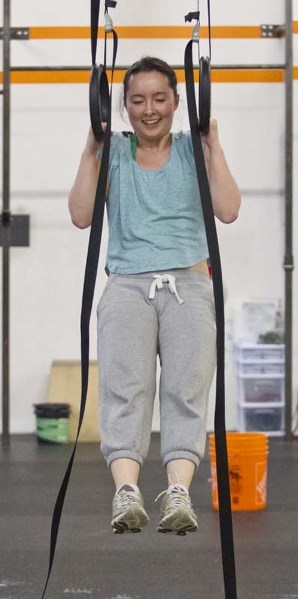Gazette reporter Amy Crofts will try a different workout each month in an attempt to inspire people to start their fitness New Year’s resolutions early, rather than just in January. If you have a workout idea, e-mail: [email protected].
The back of my neck is drenched in sweat, my arms are JELL-O and my heart is racing so fast I fear it will jump out of my chest.
My movements are getting slower as I go down for the next burpee. Maybe I will just face-plant on the floor and this will all be over … one can only hope.
“You’re doing great! 30 more seconds,” says Kelly Campbell, coach at CrossFit Edmonton, one of 10 CrossFit gyms in the Edmonton region.
“When people complain and say ‘This is so hard!’, I just say I’m giving them their money’s worth!” she chuckles.
I can’t remember my exact facial expression, but gather I smiled, painfully, in response.
In a warehouse tucked away in St. Albert’s Campbell Business Park, I am trudging my way through a basic CrossFit workout.
The workout is no more than 15 minutes in length, but it hits you hard.
Defined as “functional movements constantly varied at high intensity,” CrossFit is a strength and conditioning program founded by former gymnast Greg Glassman. The workout is based on the concept of high intensity interval training (HIIT), a training regime designed to push your body to its limits.
Workouts are usually performed in less than 30 minutes – explosive exercises done in a circuit format.
“The movements are quite quick. We’re working hard at 100 per cent each time and then taking a break,” Campbell explains.
My beginner workout consists of pedalling as fast I can on the spin bike, slamming a medicine ball on the ground, a “push press” with the same weighted ball against a wall, modified burpees (squat thrusts) done with gymnastic rings and finally sprints – with a sled full of weights attached. Each exercise is done for one minute, with a 30-second rest period and then repeated twice.
My taste of Crossfit is only a small portion of what regular “Crossfitters” take on.
Every day there is a new workout – “WOD “ or “workout of the day” – which is posted online the night before.
“You never know what you’re going to get,” says Campbell, admitting that in her six years of Crossfitting she has never taken a peek at the list before the workout, instead opting to mentally prepare for whatever comes down the pipe.
“You might be doing weightlifting; you might be doing powerlifting, flipping tires, climbing ropes or pull-ups!”
CrossFit is a full body exercise, incorporating elements of both strength and aerobic training. Crossfitters typically train three to five days per week.
The discipline has built a following around the world in just over a decade and HIIT, the principle CrossFit is based on, is the number one fitness trend predicted for 2014 by the American College of Sports Medicine.
Campbell says the regime is popular among athletes – especially young hockey players in St. Albert for the purposes of cross-training – as much as it is the non-athletic.
Critics of CrossFit report the potential risks of the workout such as musculoskeletal injury and high rates of rhabdomyolysis among athletes, a rare muscular injury that results in skeletal muscle becoming so severely damaged that it rapidly breaks down.
A study published in 2013 in the Journal of Strength and Conditioning Research – one of the few studies done on CrossFit injuries and injury rates – found that of the 132 respondents, 73.5 per cent had sustained an injury during CrossFit training. No incidences of rhabdomyolysis were reported.
The paper concluded however that injury rates with CrossFit training are similar to that reported for sports such as Olympic weightlifting, powerlifting and gymnastics and lower than competitive contact sports such as rugby.
As the possibility of injury increases with high intensity athletic pursuits, Campbell notes progression and proper technique are most important. She says when beginners first walk into the gym, they most likely won’t be climbing right to the top of the rope or for that matter, doing a full pull-up. They will start off small and work their way up.
As for injuries, she says they are no more common in CrossFit than any other sport, “sometimes you’re running and you roll an ankle, it happens here too.”
CrossFit is an athletic pursuit perfect for those that are always seeking a challenge. I admit I felt relieved after slaving for that quarter of an hour on the gym floor. The workout is nothing short of intense and you need to be in relatively good physical health to give it your all.
All I can say is, good luck!



